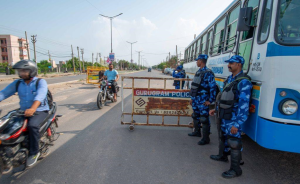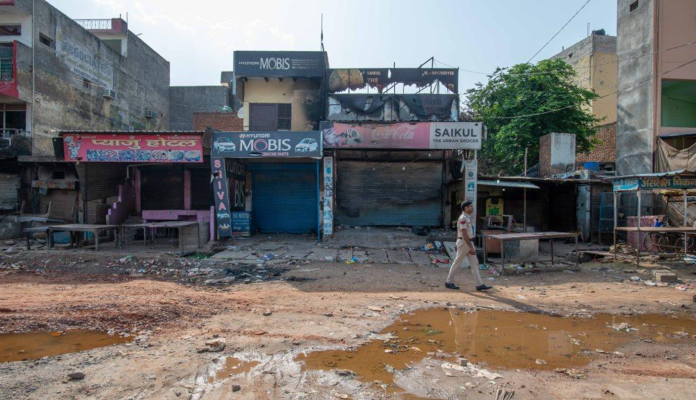
An eerie silence greeted me when I landed in Nuh town after passing past three police checkpoints. Few people are in the streets, most businesses are shuttered, and there are police pickets all over the place, giving the impression that it is a ghost town. A week prior, there were communal clashes in the town that left six people dead and numerous others hospitalised.

The police are accused of using a biased approach, arbitrarily detaining members of the minority population, even minors, and demolishing hundreds of homes and businesses with the aid of bulldozers, which has caused a panic in Nuh and the villages nearby.
Anyone passing through Nuh can’t escape the trail of destruction on either side of the road. Nuh is a small, impoverished town in Haryana that has now been reduced to a mound of rock and debris during the past week as a result of the bulldozer-assisted demolition of hundreds of homes and businesses. The gravity of the destruction caused by demolition can be imagined by the suo moto cognizance taken by the Punjab and Haryana High Court in ordering an immediate halt to the demolition.
Muslims make up 77% of the local population in the Mewat area, and many of the destroyed structures belonged to them.
What can be more ignominious than the Magistrate openly telling the media that demolitions were being carried out with the orders of the Chief Minister, attributing the violence to the shopkeepers and other roadside residents? Not feeling safe, migrant workers are leaving for their homes as the police have failed to address their safety concerns.
The local police have detained 250 people, 30 of whom are juveniles, after failing to stop the violence. Locals informed Radiance that the majority of the youth fled to the woods out of fear of being arrested.
As this correspondent talked to civil society members and locals, they were unanimous that the violence was not a chance happening but the result of well-orchestrated handiwork with the intent of communal polarisation in order to garner electoral dividends in the forthcoming Rajasthan assembly election and 2024 Lok Sabha elections.
Noted journalist Saeed Naqvi, who visited the riot-hit areas of Mewat, told Radiance that it was a dreaded plan of Hindutva forces to have at least a hundred martyrs, and their bodies to be paraded throughout the Hindi belt, “to put it in the context of Godhra on a wider scale. Despite the destruction of Muslim businesses and homes, Muslims exhibited exemplary forbearance.”
Mufti Zahed Husain Qasmi, Rector of Madrasa Moinul Islam, told Radiance that there have never been any communal riots in the Mewat region, which is famed for ideal communal harmony. Bajrang Dal and Vishva Hindu Parishad entirely organised the mobilisation for the so-called religious yatra from outside, irate crowds with weapons.
He said Muslims have shown tremendous restraint in the face of violence, despite the fact that many mosques were attacked in villages where Muslims are living in fewer numbers.
“In the roughly 400 Muslim-majority villages of Mewat, not a single Hindu temple or building was damaged, but in the areas where Muslims were the minority, they were attacked and mosques were vandalised,” Mufti Zahed underlined.
Madrasa Moinul Islam is more than 100 years old and was established by the founder of Tablighi Jamaat, Maulana Mohammad Ilyas, and it is still run under the supervision of Nizamuddin Markaz.
The miscreants of the Hindutva groups have attacked up to 13 mosques. Six mosques in Palwal, three in Hodal, three in Sohna, and one in Gurugram – where, regrettably, the deputy imam was also killed – were among those that were set on fire.
In several mosques, Hindutva mobs also attacked Tablighi Jamaat members and set religious scriptures on fire. This is not reported in the media.
The list of the affected mosques: (1) Anjuman Islam Masjid, Gurugram (2) Maulvi Jameel Wali Masjid, Sohna (3) Shahi Jami Masjid, Bara Khamba, Sohna (4) Lakkadshah Masjid, Sohna (5) Bazaar Wali Masjid, Hodal (6) Eidgah Masjid, Hodal (7) Punjabi Colony Jama Masjid, Hodal (8) Madrasa Wali Masjid, Palwal (9) Peer Gali Wali Masjid, Palwal (10) Guptaganj Wali Masjid, Palwal (11) Kali Masjid, Palwal (12) Haji Nizam Wali Masjid, Bus Stand, Palwal (13) Rasulpur Gaon Wali Mosque, Palwal.
Locals also told Radiance that despite a series of lynchings of cattle farmers and traders with impunity by cow vigilante armed bands, Muslims did not retaliate, which exemplified their patience.
In this series of lynchings, the last one was the most brutal episode: the abduction of two Meo youth from the adjoining village of Ghakmika in Rajasthan and their killing by setting them ablaze in a Bhiwani village of Loharu in February. A prime accused in this ghastly crime, Monu Manesar, who is among the prime accused along with Bittu Bajrangi in the Nuh violence, has been under the protection of the Haryana police to prevent Rajasthan police from arresting him since then.
It is a known fact now that highly outrageous and communally inflammatory videos by Monu Manesar and others went viral before the Yatra which was started by VHP just three years ago. The apprehensions of the local MLA and other prominent people in Nuh went unheeded by the district authorities, and gave permission for it.
The videos using derogatory language and the aggressive postures by VHP-Bajrang Dal hoodlums after entering Nuh worked as a trigger, supposedly with some local elements, that led to violence, resulting in the unfortunate deaths of six people, including the young Imam of Gurgaon Anjuman Masjid, who was attacked at night by a frenzied mob. The mosque was allowed to be vandalised, and the imam was shot dead as police were not deployed there to protect the vulnerable site.
The worst forms of state-sponsored retaliation took place during the curfew’s seven-day duration. To maintain a reign of terror in the town and surrounding countryside of Nuh, indiscriminate arrests and beatings of Meo adolescents are continually occurring. Bulldozers were used for mass demolition drives of stores, homes, showrooms, and other structures during the curfew and internet suspension, which indicates the true purpose of the curfew imposition, which cannot be otherwise justified without any local riots. Radiance was given accounts of the suffering of those whose businesses were destroyed in front of Nalhar Medical College.
The administration’s assertion that “illegal structures were razed down” was refuted by the victims. They bemoaned the fact that not a single store or home was spared, and instead of creating jobs for us, they had left us jobless.
Those families, who had their homes demolished, were now living in tents on Sarpanch Ahmed Ali’s property. Similarly, in Jharna Basti of Ferozpur Jhirka, where a demolition campaign resulted in the administration demolishing 150 homes and forcing the residents into homelessness.
Abdul Razzaq, a Tablighi Jamaat member from Biwan village, recalled an incident in which their Jamaat was attacked by Hindutva goons near the Bazar Wali Masjid, Palwal. Several Jamaat members sought cover on the mosque’s roof during the ensuing chaos, while Abdul Razzaq and two other people remained inside. They were brutally beaten after the goons broke into the mosque. After the police interfered, they were moved to an unidentified location and then released.
When demolition was carried out, not a single Muslim MLA was at the spot to resist the administration’s action. There are three Muslim MLAs elected from Mewat.
Radiance contacted local Congress MLA Aftab Ahmad, but he did not respond to our umpteen calls.
If these MLAs had dared the local administration, according to attorney Zulfiqar Ali, who represents clients in Nuh District Court, they would have refrained from going on a demolition rampage.
The Police and local administration’s biased approach is palpable.
Radiance talked to a host of lawyers in Nuh Court. They said all seven FIRs registered at the Nuh City police station make reference only to the Muslim community in different ways. For example, it is said: “A crowd of 600/ 700 infuriated antisocial elements were shouting slogans of Allah hu Akbar” (FIR No. 0252); or “Just as Mewat Dharmik Jalabhishek Yatra reached near Jhanda Park, all of a sudden around 600 or 700 persons belonging to one community…” (FIR No. 0254); or “At that time an aggressive crowd of 500 or 600 belonging to Meo Muslim Community carrying sticks, rods, stones, and illegal arms…” (FIR No. 0255). The reference to the other side is only as participants in the ‘Dharmik Yatra’ (Religious procession).
There is no mention whatsoever in the FIRs of violence, including the use of firearms, unleashed from the side of those taking out the so called ‘Dharmik Yatra.’ The portends of this are clear: in the FIRs, only one side is the culprit, while the side represented by Bajrang Dal and VHP rabble rousers is the victim, all the videos showing the violence indulged in by the Hindutva goons notwithstanding. Such a framing of the events in the FIRs also means that there will be arrests only of Muslim youth, as has already started happening.
In comparison, as per the information we collected from local sources and as per the claims of the Bajrang Dal and VHP themselves, even the maximum strength of the Muslim crowd at 700 was less than half of the estimated strength of 1500 to 2000 that took part in the yatra.
This one-of-a-kind fact demonstrates that, for the most part, the common Muslims of Nuh were successful in resisting becoming angered by the vile Hindutva brigands’ preparations for the yatra. However, the majority of the yatris’ mobilisation came from outside of Haryana’s traditional areas, as lawyers underlined.
Even youngsters are not exempt from the police’s current arrest frenzy. For instance, a 50-year-old man named Driver Siddiq was detained and charged under various IPC sections, including Section 302, despite not being in Nuh when the riots first started. Siddiq travelled to Rajasthan to unload a shipment, and when he returned, police detained him. Siddiq does not have any prior convictions, according to his son and brother, Salim, who spoke to Radiance.
The response to this unfortunate incident took a concerning turn as the state government and administration started one-sided demolition and arrests. Locals said the extent of fear and panic still being created sends an unambiguous message across the country that a proper lesson has been taught to the Muslims.




